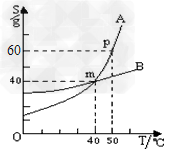问题
填空题
下图是小明同学绘制的A、B两种固体物质的溶解度曲线,根据图回答有关问题。

(1)50 ℃时,两种物质的溶解度由大到小的顺序________________;
(2)50℃时,将A、B两种恰好饱和的溶液降到40℃,所得溶液溶质质量分数的关系是:A________B(填“大于”、“小于”或“等于);
(3)40℃时将15g A物质加入50g水中,经充分溶解所形成的溶液是__________(选填“饱和”或“不饱和”)溶液。将此溶液升温至50℃,溶液的溶质质量分数__________ (填“变大”、“变小”或“不变”,假设水不蒸发),此时需要再加入____________gA,溶液才能达到饱和。
答案
⑴ A>B
⑵ 等于
⑶ 不饱和 ; 不变 ; 15
